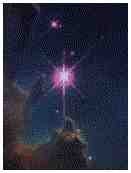
The Search for Planets Around Other Stars
Originally published in Creation 18, no 1 (December 1995): 6.
When is a planet not a planet? When it is a telescope wobble.
The death of the astronomer Professor Peter van de Kamp was announced in early July, 1995. This scientist devoted his life to the fruitless search for planets that encircled other stars. He never discovered any such planet, in spite of his initial claims.
Any planet revolving around a distant star could not be seen directly because its light would be drowned out by the glare of the star. Professor van de Kamp, however, suggested that if a star did have a planet revolving around it, then it would seem to 'wobble' when observed from a great distance because of the gravitational effect that the planet would have on it.

Using a 24-inch telescope at Sproul Observatory in Pennsylvania, Professor van de Kamp started to look for 'wobbling' stars. It was not long before he announced to the world that he had found one—star Ross 614, some 13 light-years away. He then discovered another one—Barnard's Star, the second closest star to the sun. This latter task involved taking over 4,000 photographic plates during more than a thousand nights of observations. Professor van de Kamp discovered other wobbling stars and he was subsequently heralded as the discoverer of other worlds.
In 1968, however, the observed wobbles of all these stars were shown to be due to the Professor's wobbling telescope. The stars did not wobble, but his telescope did! No wobble meant no planets. But this devastating discovery did not make this scientist give up his belief in the existence of planets revolving around other stars. Incredibly, he announced some years later that there was not one, but there were two planets circling Barnard's Star.
Commenting on such speculation (for that is all it is), Professor Michael Rowan-Robinson of Queen Mary and Westfield College, University of London, wrote that it is 'an act of faith, based on rather shaky probabilistic arguments to say that other planets like Earth exist in the Universe'.1 These are the words of an evolutionary astronomer, not those of a creationist. It cannot be over-emphasized that no other planets, other than those that are found in our own solar system, have ever been found anywhere else in the universe.
Reference
- The Infrared Landscape, New Scientist, 31 January 1980.
Editor’s note. As this issue of Creation magazine was about to be printed, the finding of another planet was announced. Whether this turns out to be a planet or not, it is admitted that it would be too hot to sustain life.
Note added later: Indeed, the early evidence for extrasolar planets was rather rubbery, so Dr White’s article accurately summarized the very weak nature of the evidence at the time of writing. But years later, evidence for the existence of extrasolar planets has now been found (The Existence and Origin of Extrasolar Planets). Of course the Bible does not say that extrasolar planets do not exist, and they even declare God’s glory (Psalm 19:1)—see New Planet Challenges Evolutionary Models. However, evolutionists want them to exist, many millions of them, hoping that somewhere else there exists a planet like Earth, where life could supposedly evolve. The chances of finding such a planet are extremely slim and even if such were found, life could not have evolved there anyway, for the same reasons that it could not have evolved on Earth.
Recommended Resources

Answers in Genesis is an apologetics ministry, dedicated to helping Christians defend their faith and proclaim the good news of Jesus Christ.
- Customer Service 800.778.3390
- Available Monday–Friday | 9 AM–5 PM ET
- © 2026 Answers in Genesis

